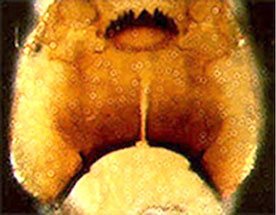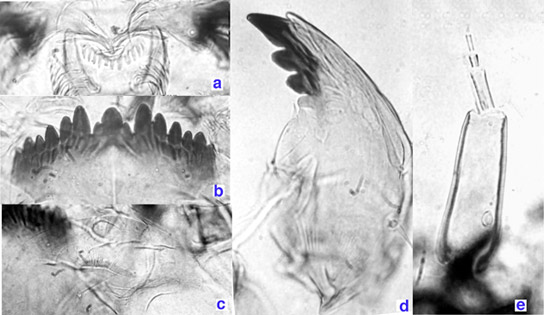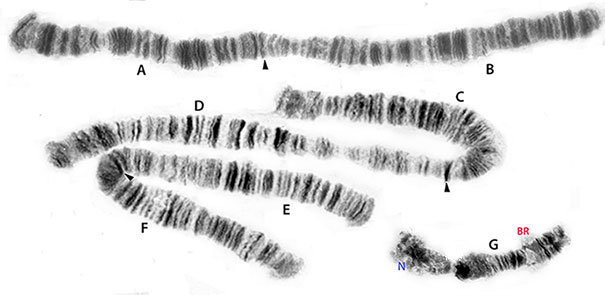C. 'proulxi': Immatures
Pupa: Length of exuvia about 5.53-7.80 mm, females larger than males: female 7.54 (7.25-7.80); male 6.88 (5.53-7.48). Inner margin of wing case 1.38-1.64 mm. (fem 1.57-1.64); male 1.38-1.59). Cephalic tubules simple, those of male (105-137 µm and 1.3-2.1x longer than width at base) larger than those of female (50-94 µm and 0.7-1.4x longer than wide); seta at least 50-90 µm long. Respiratory scar 124-152 x 48-68 µm, slightly larger in females, and narrowed to kidney-shaped, HR 2.3 (1.3-3.3); a patch of ovals and setae just anterior and lateral to scar.
Shagreen of sharp points, strongest on posterior 2/3, but at posterior only of segment VI and not obvious on segment VII. About 71 (45-84) recurved hooks, higher in females (79-84) than in males (64-79), in continuous row at rear of abdominal segment II, occupying about 90% of the width of the segment.
Clear Pedes spurii B on segment II, and Pedes spurii A on segment IV larger in females (170-185 µm) than males (95-172 µm); (i.e. about 0.20-0.26 of the segment length) and about 65-81 µm wide; that on segment V is mainly spines, perhaps 85% the size of that on segment IV; on segment VI only spines. L-setae present on anterior of intersegment III/IV and IV/V, mostly coiled or broken, but one on IV/V about 106 µm long.
Caudolateral spur (below) about 170 µm with, equally. one or two spines. Fringe of anal lobe with about 79 (66-89) flattened taeniae (males 66-79; females 82-90) on each side, initially in single row but increasing to 2 or 3 rows posteriorly.

Cephalic tubules of male (above), and spur with single spine (below)
Fourth instar larva: a small to medium (about 11.5 (10.0-15.6 mm: sexed females 10-13.3mm) melanotus-type (lateral projections only slightly developed, 0-160 µm); Ventral tubules essentially straight, 0.68-1.92 mm long, with posterior pair usually longer (means: ant. 1.37; post 1.44 mm.). Anal tubules about 360-580 µm (dorsal), 300-540 µm (ventral), 2.4-4.7 times longer than wide (longer in Wisconsin than in Canada).
Dark posterior half to two thirds of gular region, extending wider than the mentum width, higher at the edges and widest part way up (see below), frontoclypeus usually pale, but may have very slight darkening. Oesophageal opening 55.5-76 µm long and 2.9-3.4 times longer than wide (values above this apparently due to flattening during preparation).

Gula region of C. 'proulxi' - courtesy of I. Proulx
Mentum (Fig. b, below) with generally rounded teeth; c1 tooth fairly broad, c2 teeth only moderately developed, generally type IIA, occasionally III, but with wear may appear as type IB; fourth laterals usually reduced almost to level of 5th laterals (type II).
Ventromentum (Fig. c, below) about 180-221 µm wide and 2.95-3.72 times wider than deep; 1.06-1.19 times the width of the mentum; with about 45 (41-52) striae, separated by about a third or more (0.27-0.40) of the mentum width, VMR about 0.31 (0.25-0.45).
Pecten epipharyngis (Fig. a, below) of type B with about 13 (10-14) teeth. Premandible with teeth about equal or outer shorter (wear?), inner tooth about 3-5 time wider than inner tooth, which narrows markedly along its length.
Antenna (Fig. e, below) relatively short, about a third to a half VHL; basal segment about 2.7–3.8 times as long as wide; RO a third to almost half way up (0.29-0.50) segment 1; segment proportions (microns) 116 : 29 : 9 : 11.5 : 6; AR 2.06 (1.74–2.42); A3 shorter than A4 (A4/A3 abt. 1.1-1.8), but slightly longer than A5 (A5/A3 abt. 0.63-0.86).
Distance between antennal bases variable with respect to that between the S4 setae - in Canada it tends to be greater, but in Wisconsin it is less; S4 setae separated by 0.78-0.88 of the FC width. S5 setae generally slightly anterior to the nearby RO, occasionally level.
Mandible (Fig. d, below)with 3rd inner tooth only partially separated and pale (IA), but occasionally may be more separated or slightly darker (i.e. IB or IIA); about 19.7 (15-25) furrows on outer surface at the base; about 11.5 (10-13) taeniae in Pecten mandibularis; MTR about 0.35 (0.26-0.45).

Cytology: 4 polytene chromosomes with the thummi arm combination AB, CD, EF, G.
Arm G partly paired and possibly submetacentric or with a block of heterochromatin about one third along the arm; nucleolus almost terminal on short arm, BR about one third from end of long arm and possibly another close to the nucleolus. No nucleolus on any other arm. Polymorphism in arms A, B, and F, and perhaps also G.

prxA1: 1a-e, 14a-g, 3-2d, 9-8d, 13f-a, 4c-7b, 15d-a, 14ih,17h-a 3f-i, 12-10, 2c-1f, 8c-7c, 4ab, 16a-d, 18-19 i.e. as bifA3
prxA2: probably as bifA1
prxB1: Puff (gp. 7) with proximal dark bands, about 1/3 from distal end. i.e. as bifB2
prxB2: probably as bifB1
prxC1: 1 - 6b, 12b - 15, 8 - 11c, 12a - 11d, 6gh, 17a - 16, 7d-a, 6f-c, 17b - 22 i.e. as bifC1
prxD1: 1 - 3e, 10 - 7e, 13d - 18d, 4a-c, 13c - 11, 3gf 18e-g, 7d - 5, 19 - 24 i.e. as bifD2
prxE1: 1 - 3e, 5 - 10b, 4 - 3f, 10c - 13 i.e. as aberratus, bifE1
prxF1: probably 1, 9 - 7, 14 - 17, 11e - 13, 11d - 10, 2 - 6, 18 - 23 i.e. as bifF1
prxF2: small inversion a few bands distal of the characteristic bands.
prxG1: heterochromatin block and/or a BR, about one third from end with nucleolus, and a BR about one third from other end.
[ Return to C. 'proulxi" adults | Go to C. bifurcatus immatures| Go to Species list ]
|



